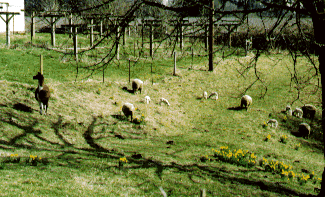Llama care, management and resources
- Llama FAQ
- Llama literature
- Basic care
- Castration
- Spaying
- About breeding llamas
- Handling young llamas
- Misdirected territorial aggression
- How old should llamas be for training and work?
Fiber from llamas
Llamas
as guardians
Classic performance llamas
Communicating
Our llama family
Just for fun
Cria photos
Training consultation
Performance
llama analysis
If you don't rescue ... DON'T BREED!

Rusty
Rusty was the first cria born to a pair of brand-new llama owners. They handled him somewhat more than they were advised to, but he was a pretty nice guy nonetheless.
Then his hormones kicked in, and Rusty only wanted to be near the females -- and he also knocked down first one, and then a second human to achieve his goal. Overnight, the joy of the really colorful youngster became fear. Castration didn't help, and the people were advised repeatedly to euthanize Rusty. But, remembering how they had loved him when he was well-mannered, Rusty's people weren't interested in taking an easy out. They were eventually steered to us, and we agreed to assume ownership of Rusty.
Rusty's only real deficit -- besides a sinfully neglected coat -- was a complete lack of understanding about the concept of personal space. He didn't have any . . . why should anyone else? After diagnosis, Rusty's deficit was quickly corrected. To test his rehab, we put Rusty in with our female herd. Not once did he even think of making a move on us. As with many llamas who are handled young, Rusty was a quick fix.
But Rusty still wasn't happy. He now knew he wasn't supposed to be king of the pasture, but he didn't integrate. In fact, Bandit -- a gelding who lives with our female herd -- suddenly became unusually protective and went out of his way to keep Rusty away. What we didn't know then was that Rusty wanted to protect the female herd, and his intentions made Bandit very upset.
One day, when we realized that our 140 pound half-Newfie was uncharacteristically petrified to go into the female pasture, it occured to us that Rusty was the cause. He was a "dog-stomper" (in our terminology), and it was this high level of protective and guarding instincts that had both allowed Rusty's original problem to manifest itself and was accounting for his misery now.
Although we had previously (and closed-mindedly) asserted that we would never consider selling a llama to guard sheep, here under our noses was a llama tailor-made for the job. After discussing what guarantees a buyer would want, and what clauses we would insert in a contract for Rusty's safety, we took out an ad in an agricultural publication and found him a home the next day. And, indeed, Rusty is finally in his element. He gathers his sheep when danger seems imminent, adores his lambs, and has successfully defended the small acreage and flock against dog and coyote attack.
And does Rusty behave himself? Like most llama
guardians, Rusty needs to be separated from the sheep when they
are worked -- although you can hardly blame a llama for assuming
a crying sheep or lamb is being harmed. His behavior toward humans
is otherwise exemplary. Rusty is a living example of that early
handling does not mean incurable problems, and also that some
llamas do achieve self-actualization as guardians of sheep.
Return to Llama Rescue and Rehabilitation
Return to Guardian Llamas
Return to Lost Creek Llamas home page